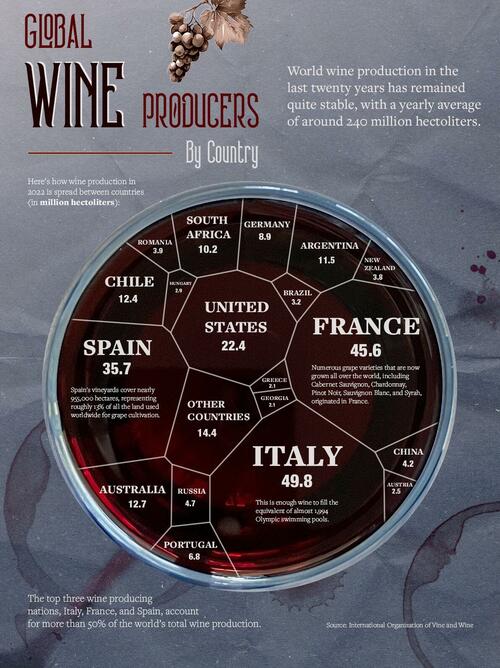
Wine gives a man fresh strength when he is wearied”
- HOMER, THE ILIAD
Wine has been in our cups, in our thoughts, and in our poems for many a millennia, from the antics of Dionysus, the Greek god of wine, to its symbolism in the Last Supper.
But, as Visual Capitalist's Pallavi Rao details below, breaking down the biggest wine producers by country in the modern era leads to some interesting surprises.
This infographic by Alberto Rojo Moro uses data from the International Organization of Vine and Wine (OIV) to visualize where wine production is concentrated in the world.
We take a quick look below.
The Top Wine Producers By Country in 2022
At the top of the list, Italy produced nearly 50 million hectoliters—or about 1,994 Olympic-sized swimming pools—of wine in 2022, accounting for nearly one-fifth of total production in the year. Less than half of that wine was sent to overseas markets, also making Italy the biggest exporter of the beverage by volume.
ℹ️ One hectoliter is equal to 100 liters and is used as a unit of measure for wine, beer, and other agricultural produce.
The country’s long coastline results in a moderate climate, allowing winemaking to occur in 20 different regions in Italy, with Veneto, Apulia, Emilia-Romagna, and Sicily leading in production.
Other known wine connoisseur countries—France (45.6 hectoliters) and Spain (35.8 million hectoliters)—rank second and third in wine production respectively. Together these three countries make up half of the world’s wine supply.
Here’s a full list of the world’s biggest wine producers by country.
| Rank | Country | Continent | Quantity (1,000 hl) | % of Total Production |
|---|---|---|---|---|
| 1 | 🇮🇹 Italy | Europe | 49,843 | 19.30% |
| 2 | 🇫🇷 France | Europe | 45,590 | 17.65% |
| 3 | 🇪🇸 Spain | Europe | 35,703 | 13.82% |
| 4 | 🇺🇸 U.S. | America | 22,385 | 8.67% |
| 5 | 🇦🇺 Australia | Oceania | 12,745 | 4.93% |
| 6 | 🇨🇱 Chile | America | 12,444 | 4.82% |
| 7 | 🇦🇷 Argentina | America | 11,451 | 4.43% |
| 8 | 🇿🇦 South Africa | Africa | 10,155 | 3.93% |
| 9 | 🇩🇪 Germany | Europe | 8,940 | 3.46% |
| 10 | 🇵🇹 Portugal | Europe | 6,777 | 2.62% |
| 11 | 🇷🇺 Russia | Europe | 4,700 | 1.82% |
| 12 | 🇨🇳 China | Asia | 4,182 | 1.62% |
| 13 | 🇳🇿 New Zealand | Oceania | 3,830 | 1.48% |
| 14 | 🇷🇴 Romania | Europe | 3,788 | 1.47% |
| 15 | 🇧🇷 Brazil | America | 3,200 | 1.24% |
| 16 | 🇭🇺 Hungary | Europe | 2,900 | 1.12% |
| 17 | 🇦🇹 Austria | Europe | 2,527 | 0.98% |
| 18 | 🇬🇪 Georgia | Europe | 2,135 | 0.83% |
| 19 | 🇬🇷 Greece | Europe | 2,127 | 0.82% |
| 20 | 🇲🇩 Moldova | Europe | 1,400 | 0.54% |
| 21 | 🇨🇭 Switzerland | Europe | 992 | 0.38% |
| 22 | 🇲🇰 North Macedonia | Europe | 936 | 0.36% |
| 23 | 🇯🇵 Japan | Asia | 830 | 0.32% |
| 24 | 🇵🇪 Peru | America | 810 | 0.31% |
| 25 | 🇺🇾 Uruguay | America | 756 | 0.29% |
| 26 | 🇧🇬 Bulgaria | Europe | 747 | 0.29% |
| 27 | 🇨🇦 Canada | America | 692 | 0.27% |
| 28 | 🇺🇦 Ukraine | Europe | 660 | 0.26% |
| 29 | 🇹🇷 Türkiye | Asia | 622 | 0.24% |
| 30 | 🇨🇿 Czech Republic | Europe | 586 | 0.23% |
| 31 | 🇭🇷 Croatia | Europe | 561 | 0.22% |
| 32 | 🇸🇮 Slovenia | Europe | 546 | 0.21% |
| 33 | 🇰🇿 Kazakhstan | Asia | 445 | 0.17% |
| 34 | 🇮🇱 Israel | Asia | 430 | 0.17% |
| 35 | 🇲🇦 Morocco | Africa | 418 | 0.16% |
| 36 | 🇹🇲 Turkmenistan | Asia | 400 | 0.15% |
| 37 | 🇲🇽 Mexico | America | 396 | 0.15% |
| 38 | 🇹🇳 Tunisia | Africa | 370 | 0.14% |
| 39 | 🇧🇾 Belarus | Europe | 340 | 0.13% |
| 40 | 🇸🇰 Slovakia | Europe | 334 | 0.13% |
| 41 | 🇦🇱 Albania | Europe | 228 | 0.09% |
| 42 | 🇺🇿 Uzbekistan | Asia | 216 | 0.08% |
| 43 | 🇩🇿 Algeria | Africa | 193 | 0.07% |
| 44 | 🇮🇳 India | Asia | 180 | 0.07% |
| 45 | 🇬🇧 UK | Europe | 91 | 0.04% |
| 46 | 🇱🇺 Luxembourg | Europe | 85 | 0.03% |
| 47 | 🇨🇾 Cyprus | Europe | 79 | 0.03% |
| 48 | 🇱🇹 Lithuania | Europe | 32 | 0.01% |
| 49 | 🇧🇪 Belgium | Europe | 30 | 0.01% |
| 50 | 🇲🇹 Malta | Europe | 13 | 0.01% |
| 51 | 🇳🇱 Netherlands | Europe | 10 | 0.00% |
| 52 | 🇵🇱 Poland | Europe | 5 | 0.00% |
| 53 | 🇩🇰 Denmark | Europe | 1 | 0.00% |
| 🌎 World | All | 258,265 | 100% |
Note: Percentages may not sum to 100% due to rounding.
The U.S., ranked 4th, is the top wine producer from the Americas, beating out other wine-producing countries like Chile (8th) and Argentina (9th).
South Africa, ranked 10th, is one of only four African countries in the dataset as winemaking isn’t as widespread on the continent as other regions in the world.
Meanwhile, China (ranked 14th) is the top wine producer from Asia. The region’s preference for other distilled spirits helps explain why the next two biggest Asian wine producers, Japan (25th) and Türkiye (31st) occupy the middle ranks.
Unsurprisingly, European countries account for two-thirds of the world’s wine supply, followed by the Americas (20%) and then Oceania (6%).
Climate Concerns for Future Wine Production
Wine production has stayed relatively stable for the last decade but climate change is coming for this industry as well.
According to the New York Times, warmer temperatures are both a blessing and curse for winemakers. Some areas once deemed too inhospitable for grapevines (like England) are starting to show potential for certain varietals and wines. At the same time, in some traditional regions, prolonged warmer weather is leading to overripening, forcing winemakers to limit the grapes’ exposure to sunlight.
And the general weather anomalies caused by climate change—floods, droughts, wildfires—all make wine production just a little more difficult than it already is.
Which prompts a question worth pouring a glass of wine over to ponder: which wine producing countries will survive, adapt, languish or thrive in the coming decades?
Wine gives a man fresh strength when he is wearied”
– HOMER, THE ILIAD
Wine has been in our cups, in our thoughts, and in our poems for many a millennia, from the antics of Dionysus, the Greek god of wine, to its symbolism in the Last Supper.
But, as Visual Capitalist’s Pallavi Rao details below, breaking down the biggest wine producers by country in the modern era leads to some interesting surprises.
This infographic by Alberto Rojo Moro uses data from the International Organization of Vine and Wine (OIV) to visualize where wine production is concentrated in the world.
We take a quick look below.
The Top Wine Producers By Country in 2022
At the top of the list, Italy produced nearly 50 million hectoliters—or about 1,994 Olympic-sized swimming pools—of wine in 2022, accounting for nearly one-fifth of total production in the year. Less than half of that wine was sent to overseas markets, also making Italy the biggest exporter of the beverage by volume.
ℹ️ One hectoliter is equal to 100 liters and is used as a unit of measure for wine, beer, and other agricultural produce.
The country’s long coastline results in a moderate climate, allowing winemaking to occur in 20 different regions in Italy, with Veneto, Apulia, Emilia-Romagna, and Sicily leading in production.
Other known wine connoisseur countries—France (45.6 hectoliters) and Spain (35.8 million hectoliters)—rank second and third in wine production respectively. Together these three countries make up half of the world’s wine supply.
Here’s a full list of the world’s biggest wine producers by country.
| Rank | Country | Continent | Quantity (1,000 hl) |
% of Total Production |
|---|---|---|---|---|
| 1 | 🇮🇹 Italy | Europe | 49,843 | 19.30% |
| 2 | 🇫🇷 France | Europe | 45,590 | 17.65% |
| 3 | 🇪🇸 Spain | Europe | 35,703 | 13.82% |
| 4 | 🇺🇸 U.S. | America | 22,385 | 8.67% |
| 5 | 🇦🇺 Australia | Oceania | 12,745 | 4.93% |
| 6 | 🇨🇱 Chile | America | 12,444 | 4.82% |
| 7 | 🇦🇷 Argentina | America | 11,451 | 4.43% |
| 8 | 🇿🇦 South Africa | Africa | 10,155 | 3.93% |
| 9 | 🇩🇪 Germany | Europe | 8,940 | 3.46% |
| 10 | 🇵🇹 Portugal | Europe | 6,777 | 2.62% |
| 11 | 🇷🇺 Russia | Europe | 4,700 | 1.82% |
| 12 | 🇨🇳 China | Asia | 4,182 | 1.62% |
| 13 | 🇳🇿 New Zealand | Oceania | 3,830 | 1.48% |
| 14 | 🇷🇴 Romania | Europe | 3,788 | 1.47% |
| 15 | 🇧🇷 Brazil | America | 3,200 | 1.24% |
| 16 | 🇭🇺 Hungary | Europe | 2,900 | 1.12% |
| 17 | 🇦🇹 Austria | Europe | 2,527 | 0.98% |
| 18 | 🇬🇪 Georgia | Europe | 2,135 | 0.83% |
| 19 | 🇬🇷 Greece | Europe | 2,127 | 0.82% |
| 20 | 🇲🇩 Moldova | Europe | 1,400 | 0.54% |
| 21 | 🇨🇭 Switzerland | Europe | 992 | 0.38% |
| 22 | 🇲🇰 North Macedonia | Europe | 936 | 0.36% |
| 23 | 🇯🇵 Japan | Asia | 830 | 0.32% |
| 24 | 🇵🇪 Peru | America | 810 | 0.31% |
| 25 | 🇺🇾 Uruguay | America | 756 | 0.29% |
| 26 | 🇧🇬 Bulgaria | Europe | 747 | 0.29% |
| 27 | 🇨🇦 Canada | America | 692 | 0.27% |
| 28 | 🇺🇦 Ukraine | Europe | 660 | 0.26% |
| 29 | 🇹🇷 Türkiye | Asia | 622 | 0.24% |
| 30 | 🇨🇿 Czech Republic | Europe | 586 | 0.23% |
| 31 | 🇭🇷 Croatia | Europe | 561 | 0.22% |
| 32 | 🇸🇮 Slovenia | Europe | 546 | 0.21% |
| 33 | 🇰🇿 Kazakhstan | Asia | 445 | 0.17% |
| 34 | 🇮🇱 Israel | Asia | 430 | 0.17% |
| 35 | 🇲🇦 Morocco | Africa | 418 | 0.16% |
| 36 | 🇹🇲 Turkmenistan | Asia | 400 | 0.15% |
| 37 | 🇲🇽 Mexico | America | 396 | 0.15% |
| 38 | 🇹🇳 Tunisia | Africa | 370 | 0.14% |
| 39 | 🇧🇾 Belarus | Europe | 340 | 0.13% |
| 40 | 🇸🇰 Slovakia | Europe | 334 | 0.13% |
| 41 | 🇦🇱 Albania | Europe | 228 | 0.09% |
| 42 | 🇺🇿 Uzbekistan | Asia | 216 | 0.08% |
| 43 | 🇩🇿 Algeria | Africa | 193 | 0.07% |
| 44 | 🇮🇳 India | Asia | 180 | 0.07% |
| 45 | 🇬🇧 UK | Europe | 91 | 0.04% |
| 46 | 🇱🇺 Luxembourg | Europe | 85 | 0.03% |
| 47 | 🇨🇾 Cyprus | Europe | 79 | 0.03% |
| 48 | 🇱🇹 Lithuania | Europe | 32 | 0.01% |
| 49 | 🇧🇪 Belgium | Europe | 30 | 0.01% |
| 50 | 🇲🇹 Malta | Europe | 13 | 0.01% |
| 51 | 🇳🇱 Netherlands | Europe | 10 | 0.00% |
| 52 | 🇵🇱 Poland | Europe | 5 | 0.00% |
| 53 | 🇩🇰 Denmark | Europe | 1 | 0.00% |
| 🌎 World | All | 258,265 | 100% |
Note: Percentages may not sum to 100% due to rounding.
The U.S., ranked 4th, is the top wine producer from the Americas, beating out other wine-producing countries like Chile (8th) and Argentina (9th).
South Africa, ranked 10th, is one of only four African countries in the dataset as winemaking isn’t as widespread on the continent as other regions in the world.
Meanwhile, China (ranked 14th) is the top wine producer from Asia. The region’s preference for other distilled spirits helps explain why the next two biggest Asian wine producers, Japan (25th) and Türkiye (31st) occupy the middle ranks.
Unsurprisingly, European countries account for two-thirds of the world’s wine supply, followed by the Americas (20%) and then Oceania (6%).
Climate Concerns for Future Wine Production
Wine production has stayed relatively stable for the last decade but climate change is coming for this industry as well.
According to the New York Times, warmer temperatures are both a blessing and curse for winemakers. Some areas once deemed too inhospitable for grapevines (like England) are starting to show potential for certain varietals and wines. At the same time, in some traditional regions, prolonged warmer weather is leading to overripening, forcing winemakers to limit the grapes’ exposure to sunlight.
And the general weather anomalies caused by climate change—floods, droughts, wildfires—all make wine production just a little more difficult than it already is.
Which prompts a question worth pouring a glass of wine over to ponder: which wine producing countries will survive, adapt, languish or thrive in the coming decades?
Loading…





